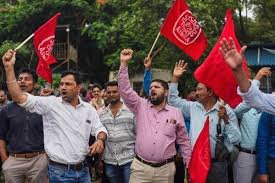On July 9, 2025, India witnessed a massive nationwide strike, dubbed “Bharat Bandh” (Shut Down India), as over 25 crore workers from sectors including banking, coal mining, postal services, and public transport united to protest Prime Minister Narendra Modi’s economic reforms. Organized by a coalition of 10 major trade unions, alongside farmers’ and rural workers’ groups, the one-day industrial action disrupted key services across states like West Bengal, Kerala, Bihar, and Jharkhand. The strike targeted Modi’s privatization push, new labor codes, and policies perceived as favoring corporate interests over workers’ rights. This article explores the causes, impact, and implications of the Bharat Bandh, shedding light on the growing tensions between Modi’s economic vision and India’s workforce.
The Spark: Why Workers Struck
Opposition to New Labor Codes
At the heart of the Bharat Bandh lies fierce opposition to the four labor codes introduced by the Modi government between 2019 and 2020: the Code on Wages, Industrial Relations Code, Code on Social Security, and Occupational Safety, Health and Working Conditions Code. These codes, consolidating 29 labor laws, aim to simplify regulations, reduce compliance costs, and attract foreign investment by enhancing “ease of doing business.” However, trade unions argue they erode workers’ rights by extending working hours, weakening collective bargaining, and restricting the ability to strike legally. Amarjeet Kaur, General Secretary of the All India Trade Union Congress (AITUC), stated, “These codes favor employers and decriminalize violations, leaving workers vulnerable.”
Privatization and Job Security Concerns
The government’s aggressive privatization of state-run enterprises, including coal mines, railways, and public sector banks, has sparked fears of job losses and reduced benefits. The unions claim that outsourcing, contractual employment, and casualization of the workforce are undermining job security for millions. Rajendra Pratholi, an activist with the Communist Party of India (Marxist-Leninist), accused the government of “snatching workers’ benefits to favor capitalists and industrialists.” Farmers’ groups, joining the strike, demanded higher minimum support prices for crops like wheat and rice, aligning their grievances with workers against policies seen as “pro-corporate.”
Economic Hardships
Unions highlighted rising unemployment, soaring prices of essential commodities, and stagnant wages as key grievances. The joint forum of trade unions alleged that Modi’s policies have deepened inequality, reduced social sector spending on education and health, and burdened the poor and middle class. The absence of the annual labor conference for a decade further fueled discontent, with unions claiming the government sidelined workers’ voices in favor of corporate interests, particularly those of conglomerates like Adani and Ambani.
The Bharat Bandh: Scale and Impact
Nationwide Disruptions
The Bharat Bandh, backed by over 25 crore workers, caused significant disruptions across multiple sectors. Coal mining operations halted in states like Jharkhand and West Bengal, while train services faced delays as protestors blocked railway tracks in Bihar and Odisha. Banking and insurance services were hit, with many branches operating with skeleton staff. Public transport, including state-run buses, was affected in Kerala, Tamil Nadu, and Karnataka, stranding commuters. In Tamil Nadu, trade union leader A. Soundararajan reported that police detained around 30,000 protesting workers, highlighting the strike’s intensity. Manufacturing activities, particularly in industrial hubs, also faced disruptions, with factories reporting reduced output.
Regional Variations
The strike’s impact varied across India. Left-leaning states like West Bengal and Kerala saw near-total shutdowns, with shops, banks, and transport services heavily affected. In contrast, BJP-ruled states like Gujarat and Uttar Pradesh reported minimal disruptions, with commercial markets functioning normally, as claimed by BJP MP Praveen Khandelwal. Tamil Nadu saw normal operations in some areas despite detentions, while Punjab, Haryana, and Rajasthan witnessed farmers’ demonstrations in solidarity, including road blockades. Posts on X noted strong participation in eastern and southern states, with @dailyupdates04 reporting, “Disruptions in Bengal, Bihar, Odisha; Tamil Nadu normal.”
Government’s Response
The Modi government has not formally commented on the Bharat Bandh, consistent with its tendency to dismiss union claims. A senior official from the Union Ministry of Labour and Employment called the strike “inconsequential,” noting that 213 trade unions opted out and most states have already implemented the labor codes. The government argues that the reforms are essential for attracting foreign direct investment and boosting manufacturing, pointing to billions in financial incentives offered to companies. However, unions like the Centre of Indian Trade Unions (CITU) reported widespread highway and rail blockades, signaling significant worker resistance.
The Bigger Picture: Modi’s Economic Vision vs. Workers’ Rights
Modi’s Reform Agenda
Modi’s economic reforms, including the labor codes and privatization initiatives, are part of the “Make in India” campaign to position India as a global manufacturing hub. By easing labor laws, the government aims to streamline business operations, reduce compliance burdens, and attract foreign companies. States like Punjab, Karnataka, and Tamil Nadu have already rolled out most of the labor codes, with only West Bengal and Kerala resisting. The government’s push for foreign investment has led to relaxed regulations in sectors like coal and railways, but critics argue this prioritizes corporate profits over workers’ welfare.
Union and Farmer Demands
The striking workers and farmers outlined a clear set of demands:
- Repeal of Labor Codes: Withdraw the four codes to restore workers’ rights to unionize and strike.
- Halt Privatization: Stop the sale of public sector enterprises and outsourcing of jobs.
- Higher Wages and Job Creation: Fill government vacancies, increase MGNREGA wages, and create urban employment schemes.
- Support for Farmers: Raise minimum support prices for crops and address rural economic distress.
- Social Spending: Increase investment in education, health, and civic amenities to reduce inequality.
Challenges to the Strike
Despite its scale, the Bharat Bandh faced challenges. The absence of 213 trade unions weakened its impact in some regions, and the government’s claim that reforms are widely accepted by states undermined the unions’ narrative. Amarjeet Kaur countered that investments have not materialized due to global economic slowdowns and domestic issues like communal tensions, questioning India’s appeal as an investment destination. Posts on X, such as @sherryrehman’s, criticized Modi’s “elite corporatist focus,” while @catale7a lamented the lack of media coverage, suggesting the strike struggled for visibility in mainstream outlets.
What’s Next for Workers and the Government?
Continued Resistance
Trade unions, led by figures like Kaur and Tapan Sen of CITU, vowed a “prolonged fight” against the labor codes, with plans for further protests if demands are unmet. The participation of farmers’ groups from Punjab, Haryana, and Rajasthan signals a broadening coalition, potentially escalating future actions. However, the government’s dismissal of the strike and the partial implementation of reforms across states suggest a challenging road ahead for unions.
Economic and Political Implications
The Bharat Bandh poses a fresh challenge to Modi’s economic agenda, particularly as he seeks to bolster India’s global investment appeal during international engagements, such as his recent Namibia visit. The strike’s timing, amid a narrower 2024 election victory, highlights growing discontent with policies perceived as favoring corporates. If unresolved, these tensions could impact Modi’s political capital and India’s economic stability, especially if disruptions persist.
Advice for Affected Stakeholders
- Workers and Unions: Stay informed via official union channels and platforms like X for updates on future actions. Coordinate with farmers’ groups to strengthen collective bargaining power.
- Commuters and Businesses: Check local news for disruptions, especially in banking, transport, and mining sectors. Plan alternative travel routes in states like Bihar and West Bengal.
- Students and Educators: Monitor school and college closure announcements, particularly in Kerala and Karnataka, where disruptions were significant.
How to Stay Updated
For real-time updates, follow trusted sources like The Times of India, The Indian Express, and Business Today, or visit pib.gov.in for government statements. X accounts like @IndiaToday and @NewIndianXpress provide live insights, though verify claims with official sources due to potential misinformation. Visual content, such as images of protests or blocked railways, may be available from accounts like @dailyupdates04 or @gulf_news, but permission is required for use.
Conclusion
The Bharat Bandh of July 9, 2025, marked a powerful stand by over 25 crore workers and farmers against Narendra Modi’s economic reforms, spotlighting deep-seated concerns over labor codes, privatization, and inequality. While the strike disrupted coal mining, banking, and transport in several states, its impact was tempered by limited participation in BJP-ruled regions and the government’s dismissive stance. As unions gear up for a prolonged battle, the clash between Modi’s pro-corporate vision and workers’ demands for rights and welfare sets the stage for a pivotal moment in India’s economic and political landscape. Stay tuned for updates as this struggle unfolds.
Keywords: Bharat Bandh 2025, Indian workers strike, Narendra Modi, economic reforms, labor codes, privatization, trade unions, farmers’ protests, unemployment, India economy.

